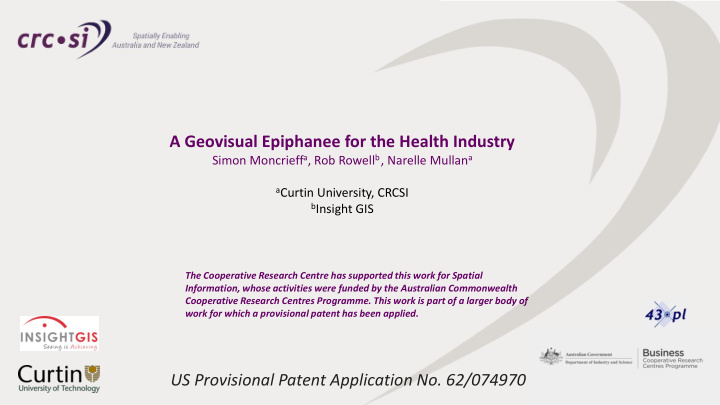



A Geovisual Epiphanee for the Health Industry Simon Moncrieff a , Rob Rowell b , Narelle Mullan a a Curtin University, CRCSI b Insight GIS The Cooperative Research Centre has supported this work for Spatial Information, whose activities were funded by the Australian Commonwealth Cooperative Research Centres Programme. This work is part of a larger body of work for which a provisional patent has been applied. US Provisional Patent Application No. 62/074970
What is CRC•SI ? Universities (RESEARCH) CRCSI SI Federal & State Australian/NZ Companies Govt Agencies -43PL (SPATIAL INFORMATION) (COMMERCIAL CAPABILITY)
Restrict tricted ed Access cess = Li Limit ited d An Analysi lysis sensitivity of health information (and mapped or geo-enable it.... OMG) RISK …. creates restrictions and limitations LOST… health + place analysis
Big Data + Many Data Sources + Numerous Queries health industry = extremely large data sets enormous number of potential queries unfeasible to produce all results ahead of time
(Analysis by) Visualisation
(Analysis by) Visualisation relate disease, diagnosis and service delivery to a location visualise the relationships between exposure, healthcare and outcomes issues quickly identified + actions effectively implemented
(Communication by) Visualisation “Our eyesi esight t is is a g a grea eat t so sour urce ce of of information”
Epiphanee: Where did it begin Research Project between WA Dept of Health, CRCSI and Curtin Uni “Enabling wider access to Health Data for efficient delivery of services while ensuring confidentiality is maintained”
Epiphanee – Maximising Result / Minimising Risk • Processes data on the fly allowing Query Epiphanee Generation users to generate their own query Data Generation & specifications. Visualisation V1 • Delivers results without the data maintaining privacy Result1 V2 • Privacy module allows richer V3 interpretation and analysis Dataset Result2 V4 • Being used for mapping of summary Result3 statistics (e.g. age standardised rate). V5
Epiphanee – Comparing Traditional Outputs Results with no privacy filter (unrestricted access) Results using Epiphanee developed privacy filter Results using conventional privacy methods
Case Study – • Department of Health WA – Hospitalisation (~11 million records) and mortality data (~100,000 records) – Summary statistics with a thematic map as output. – Data export: Excel, ShapeFile, PDF. • Royal Hobart Hospital – Hospitalisation data (~50,000 events) – Point location, demographic, epidemiological and financial data – Result: Rapid generation of thematic maps for statistical areas (SA1, SA2) – Linked to ABS data for extended visualisations • In both cases, Epiphanee dynamically linked data to normalise the output
Example Image 1 -
Example Image 2
Outcomes Proportion of queries Propor portion ion of Defau efault lt Dynamic ic Total Reporti ting returning a result compared to the number 50% 6.8% 100% of areas return when no privacy filter is employed. 90% 0.1% 98.7%
Outcomes minutes not days currency of data
Outcomes time for deeper analysis “Detect the expected + Discover the unexpected” Thomas and Cook 2005
Outcomes easier consumption
“The flexibility and privacy protection built into Epiphanee will allow access to detailed aggregated health information that is more timely, and enable a wider range of health users to produce customised outputs from their desktop“ Dr Tarun Weeramanthri Executive Director Public Health and Clinical Services Division Dept of Health, WA
Epiphanee has demonstrated that it is possible to enable wider access to Health Data for efficient delivery of services while ensuring confidentiality is maintained Thank You
Recommend
More recommend